Experimental Study on the Working Efficiency and Exergy Efficiency of the Vehicle-Mounted Thermoelectric Generator for Cold Chain Logistics Transportation Vehicle
Abstract
:1. Introduction
2. Working Efficiency and Exergy Efficiency of Cold Chain Logistics Transport Vehicles Thermoelectric Generator (CLVTEG)
2.1. Working Efficiency
2.2. Exergy Efficiency
3. Introduction of CLVTEG Experimental System
3.1. CLVTEG Experimental System
3.2. Enhanced CLVTEG Performance
4. Experimental Results and Analysis
5. Conclusions
- The working efficiency of CLVTEG was evaluated based on the output power and heat absorbed by the hot side from the heat source. It was observed that the addition of copper foam in the central area of the high-temperature gas channel significantly improved the performance of CLVTEG. The CLVTEG with 40 PPI copper foam exhibited the highest output power, while the CLVTEG with 10 PPI copper foam had the lowest output power. The increase in output power was attributed to enhanced heat transfer efficiency and temperature difference between the hot and cold sides of the thermoelectric module. Moreover, the addition of higher PPI copper foam provided more heat conduction paths and improved flow disturbance strength, resulting in higher output power.
- The exergy efficiency of CLVTEG was determined by the proportion of temperature difference converted into electricity. It was found that both working efficiency and exergy efficiency exhibited a maximum peak with the change in load resistance. When the load resistance was equal to the internal resistance of CLVTEG, both efficiencies reached their maximum values. Exergy efficiency was more sensitive to changes in load resistance near the peak value. The addition of copper foam increased the working efficiency and exergy efficiency of CLVTEG. The CLVTEG with 10 PPI copper foam demonstrated higher efficiencies compared to those with 20 PPI and 40 PPI copper foam. The change in exergy efficiency was more pronounced than that of working efficiency.
- Increasing the temperature difference between the hot and cold sides of CLVTEG led to an initial increase and subsequent decrease in both working efficiency and exergy efficiency. The addition of copper foam improved heat conduction and disturbance within the channel, resulting in a more uniform temperature distribution and reduced temperature difference. This allowed for better heat utilization by the thermoelectric module, leading to higher efficiencies. The addition of 10 PPI copper foam yielded the best performance, and further increases in temperature difference had diminishing returns.
Author Contributions
Funding
Data Availability Statement
Conflicts of Interest
References
- Sharifi, S.; Sedaghat, M.; Farhadi, P.; Ghadimi, N.; Taheri, B. Environmental economic dispatch using improved artificial bee colony algorithm. Evol. Syst. 2017, 8, 233–242. [Google Scholar] [CrossRef]
- Taheri, B.; Aghajani, G.; Sedaghat, M. Economic dispatch in a power system considering environmental pollution using a multi-objective particle swarm optimization algorithm based on the Pareto criterion and fuzzy logic. Int. J. Energy Environ. Eng. 2017, 8, 99–107. [Google Scholar] [CrossRef] [Green Version]
- He, W.; Zhang, G.; Zhang, X.; Ji, J.; Li, G.; Zhao, X. Recent development and application of thermoelectric generator and cooler. Appl. Energy 2015, 143, 1–25. [Google Scholar] [CrossRef]
- Pourkiaei, S.M.; Ahmadi, M.H.; Sadeghzadeh, M.; Moosavi, S.; Pourfayaz, F.; Chen, L.; Yazdi, M.A.P.; Kumar, R. Thermoelectric cooler and thermoelectric generator devices: A review of present and potential applications, modeling and materials. Energy 2019, 186, 115849. [Google Scholar] [CrossRef]
- Champier, D. Thermoelectric generators: A review of applications. Energy Convers. Manag. 2017, 140, 167–181. [Google Scholar] [CrossRef]
- Amatya, R.; Ram, R.J. Solar thermoelectric generator for micropower applications. J. Electron. Mater. 2010, 39, 1735–1740. [Google Scholar] [CrossRef]
- Yan, J.; Liao, X.; Yan, D.; Chen, Y. Review of micro thermoelectric generator. J. Microelectromechanical Syst. 2018, 27, 1–18. [Google Scholar] [CrossRef]
- Niu, X.; Yu, J.; Wang, S. Experimental study on low-temperature waste heat thermoelectric generator. J. Power Sources 2009, 188, 621–626. [Google Scholar] [CrossRef]
- Kim, S.J.; We, J.H.; Cho, B.J. A wearable thermoelectric generator fabricated on a glass fabric. Energy Environ. Sci. 2014, 7, 1959–1965. [Google Scholar] [CrossRef]
- Jouhara, H.; Żabnieńska-Góra, A.; Khordehgah, N.; Doraghi, Q.; Ahmad, L.; Norman, L.; Axcell, B.; Wrobel, L.; Dai, S. Thermoelectric generator (TEG) technologies and applications. Int. J. Thermofluids 2021, 9, 100063. [Google Scholar] [CrossRef]
- Karri, M.A.; Thacher, E.F.; Helenbrook, B.T. Exhaust energy conversion by thermoelectric generator: Two case studies. Energy Convers. Manag. 2011, 52, 1596–1611. [Google Scholar] [CrossRef]
- Luo, D.; Yan, Y.; Chen, W.-H.; Yang, X.; Chen, H.; Cao, B.; Zhao, Y. A comprehensive hybrid transient CFD-thermal resistance model for automobile thermoelectric generators. Int. J. Heat Mass Transf. 2023, 211, 124203. [Google Scholar] [CrossRef]
- Li, P.; Cai, L.; Zhai, P.; Tang, X.; Zhang, Q.; Niino, M. Design of a concentration solar thermoelectric generator. J. Electron. Mater. 2010, 39, 1522–1530. [Google Scholar] [CrossRef]
- He, W.; Wang, S.; Lu, C.; Zhang, X.; Li, Y. Influence of different cooling methods on thermoelectric performance of an engine exhaust gas waste heat recovery system. Appl. Energy 2016, 162, 1251–1258. [Google Scholar] [CrossRef]
- Lu, C.; Wang, S.; Chen, C.; Li, Y. Effects of heat enhancement for exhaust heat exchanger on the performance of thermoelectric generator. Appl. Therm. Eng. 2015, 89, 270–279. [Google Scholar] [CrossRef]
- Zhao, Y.; Wang, S.; Ge, M.; Liang, Z.; Liang, Y.; Li, Y. Performance investigation of an intermediate fluid thermoelectric generator for automobile exhaust waste heat recovery. Appl. Energy 2019, 239, 425–433. [Google Scholar] [CrossRef]
- He, W.; Wang, S.; Zhang, X.; Li, Y.; Lu, C. Optimization design method of thermoelectric generator based on exhaust gas parameters for recovery of engine waste heat. Energy 2015, 91, 1–9. [Google Scholar] [CrossRef]
- Zhao, Y.; Wang, S.; Ge, M.; Li, Y.; Liang, Z. Analysis of thermoelectric generation characteristics of flue gas waste heat from natural gas boiler. Energy Convers. Manag. 2017, 148, 820–829. [Google Scholar] [CrossRef]
- Li, Y.; Wang, S.; Zhao, Y.; Lu, C. Experimental study on the influence of porous foam metal filled in the core flow region on the performance of thermoelectric generators. Appl. Energy 2017, 207, 634–642. [Google Scholar] [CrossRef]
- Ge, M.; Zhao, Y.; Li, Y.; He, W.; Xie, L.; Zhao, Y. Structural optimization of thermoelectric modules in a concentration photovoltaic–thermoelectric hybrid system. Energy 2022, 244, 123202. [Google Scholar] [CrossRef]
- He, W.; Wang, S.; Li, Y.; Zhao, Y. Structural size optimization on an exhaust exchanger based on the fluid heat transfer and flow resistance characteristics applied to an automotive thermoelectric generator. Energy Convers. Manag. 2016, 129, 240–249. [Google Scholar] [CrossRef]
- Zhao, Y.; Fan, Y.; Li, W.; Li, Y.; Ge, M.; Xie, L. Experimental investigation of heat pipe thermoelectric generator. Energy Convers. Manag. 2022, 252, 115123. [Google Scholar] [CrossRef]
- Zhao, Y.; Wang, S.; Ge, M.; Liang, Z.; Liang, Y.; Li, Y. Performance analysis of automobile exhaust thermoelectric generator system with media fluid. Energy Convers. Manag. 2018, 171, 427–437. [Google Scholar] [CrossRef]
- Zhao, Y.; Wang, S.; Ge, M.; Li, Y.; Yang, Y. Energy and exergy analysis of thermoelectric generator system with humidified flue gas. Energy Convers. Manag. 2018, 156, 140–149. [Google Scholar] [CrossRef]
- He, W.; Wang, S.; Zhao, Y.; Li, Y. Effects of heat transfer characteristics between fluid channels and thermoelectric modules on optimal thermoelectric performance. Energy Convers. Manag. 2016, 113, 201–208. [Google Scholar] [CrossRef]
- Li, Y.; Wang, S.; Zhao, Y. Experimental study on heat transfer enhancement of gas tube partially filled with metal foam. Exp. Therm. Fluid Sci. 2018, 97, 408–416. [Google Scholar] [CrossRef]
- Zhao, Y.; Wang, S.; Ge, M.; Li, Y.; Liang, Z.; Yang, Y. Performance analysis of a thermoelectric generator applied to wet flue gas waste heat recovery. Appl. Energy 2018, 228, 2080–2089. [Google Scholar] [CrossRef]
- Ge, M.; Li, Z.; Zhao, Y.; Xuan, Z.; Li, Y.; Zhao, Y. Experimental study of thermoelectric generator with different numbers of modules for waste heat recovery. Appl. Energy 2022, 322, 119523. [Google Scholar] [CrossRef]
- Zhao, Y.; Lu, M.; Li, Y.; Ge, M.; Xie, L.; Liu, L. Characteristics analysis of an exhaust thermoelectric generator system with heat transfer fluid circulation. Appl. Energy 2021, 304, 117896. [Google Scholar] [CrossRef]
- Zhao, Y.; Wang, S.; Li, Y. Thermoelectric power generation using LNG cold energy and flue gas heat. Energy Procedia 2017, 105, 1932–1935. [Google Scholar] [CrossRef]
- Li, Y.; Wang, S.; Zhao, Y.; Yue, L. Experimental study on the effect of core flow heat transfer enhancement on the performance of TEG. Energy Rep. 2022, 8, 575–580. [Google Scholar] [CrossRef]
- Zhao, Y.; Lu, M.; Li, Y.; Wang, Y.; Ge, M. Numerical investigation of an exhaust thermoelectric generator with a perforated plate. Energy 2023, 263, 125776. [Google Scholar] [CrossRef]
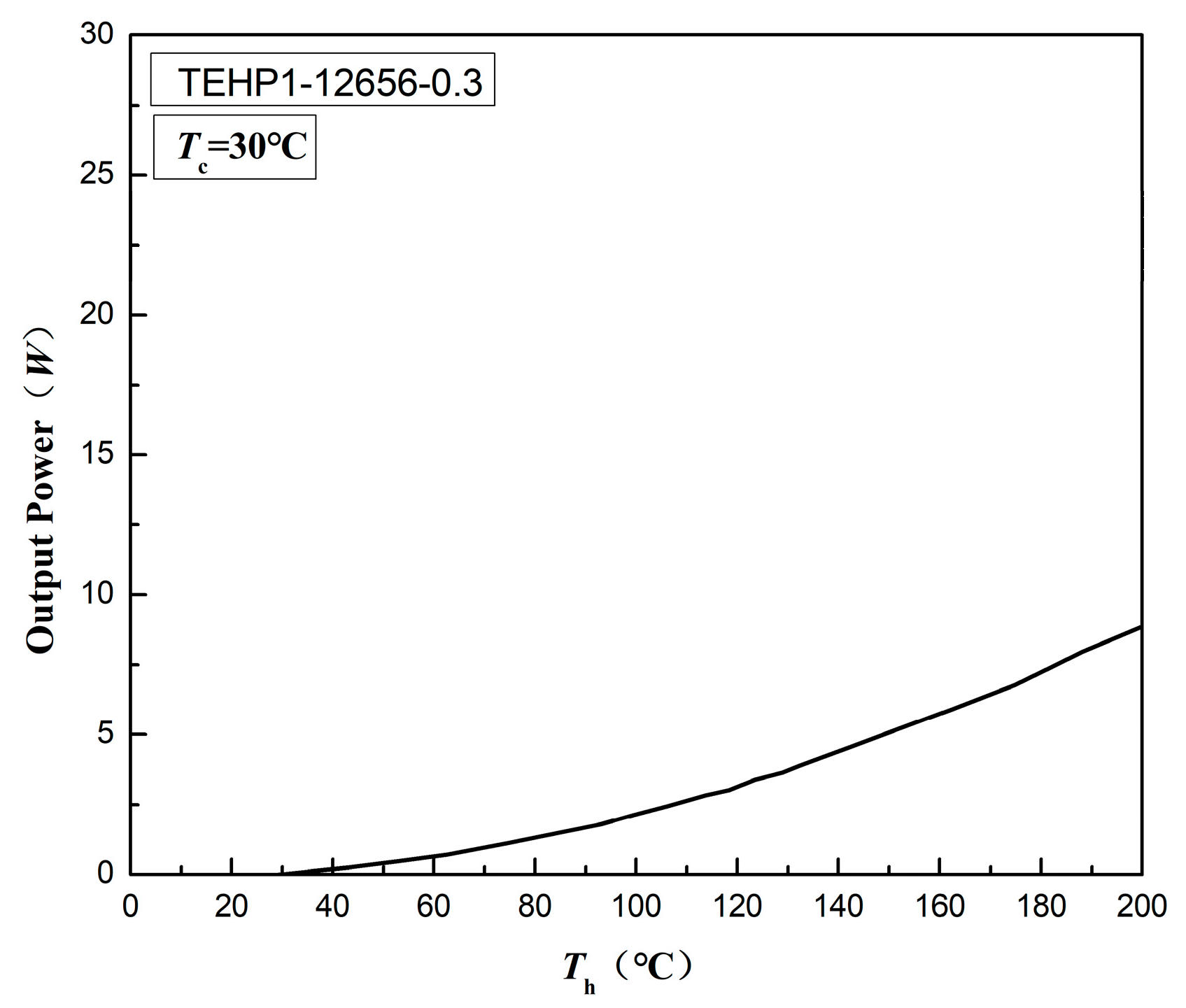

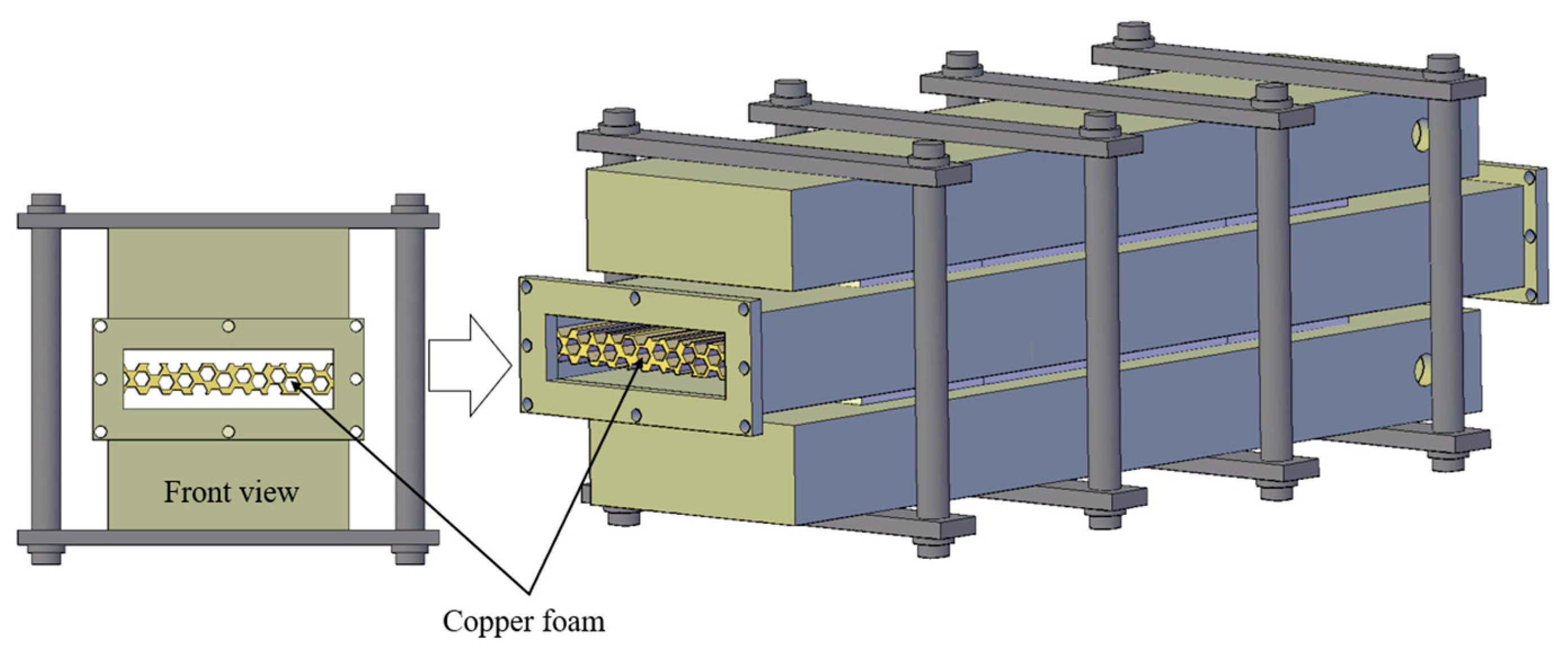
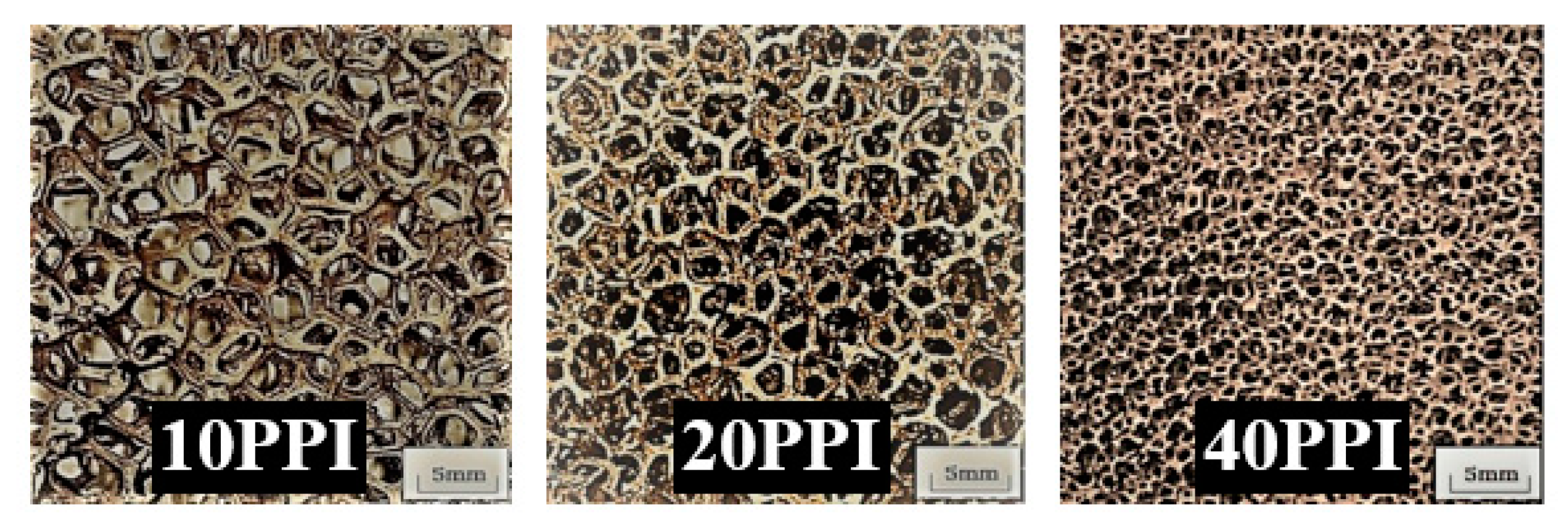
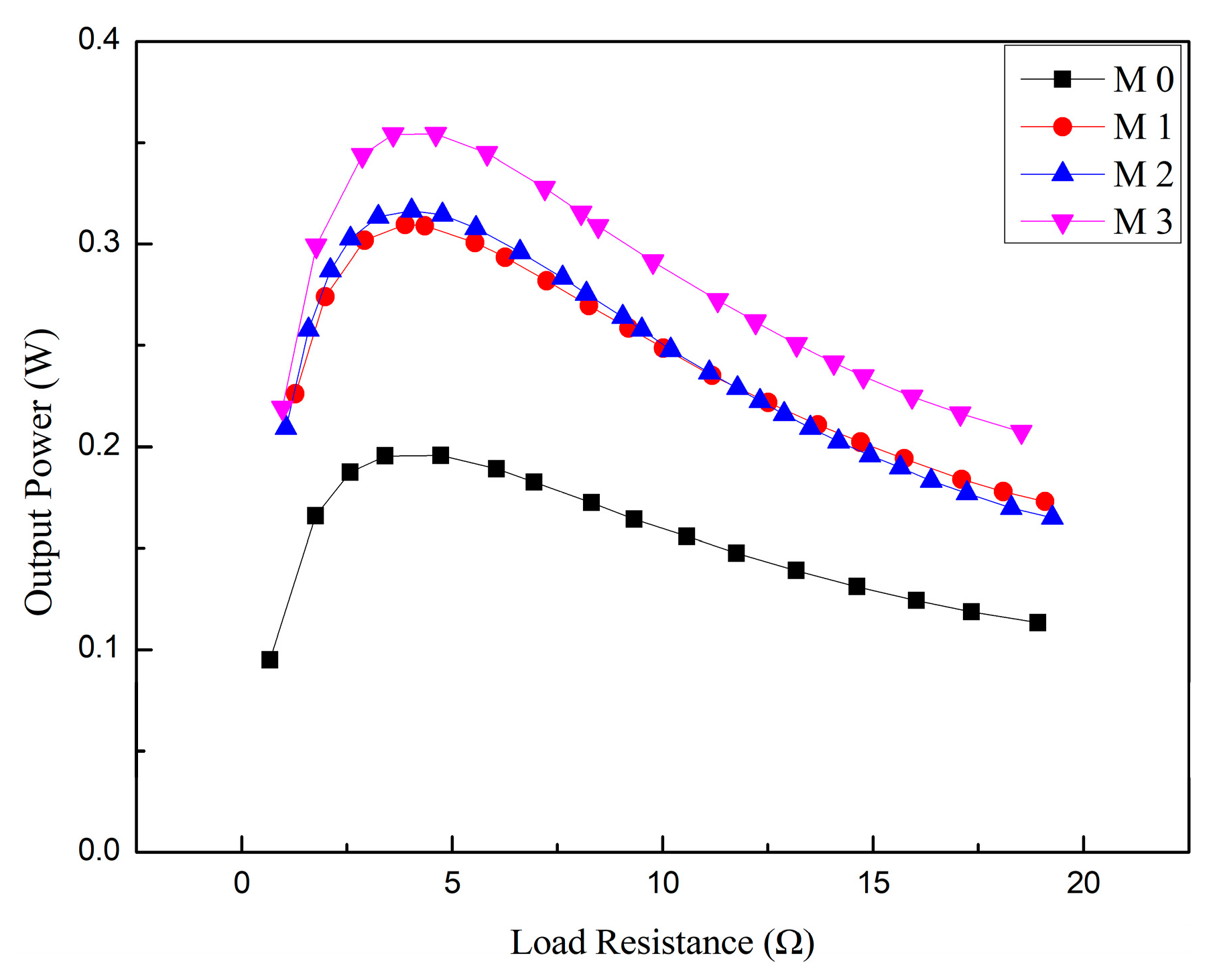


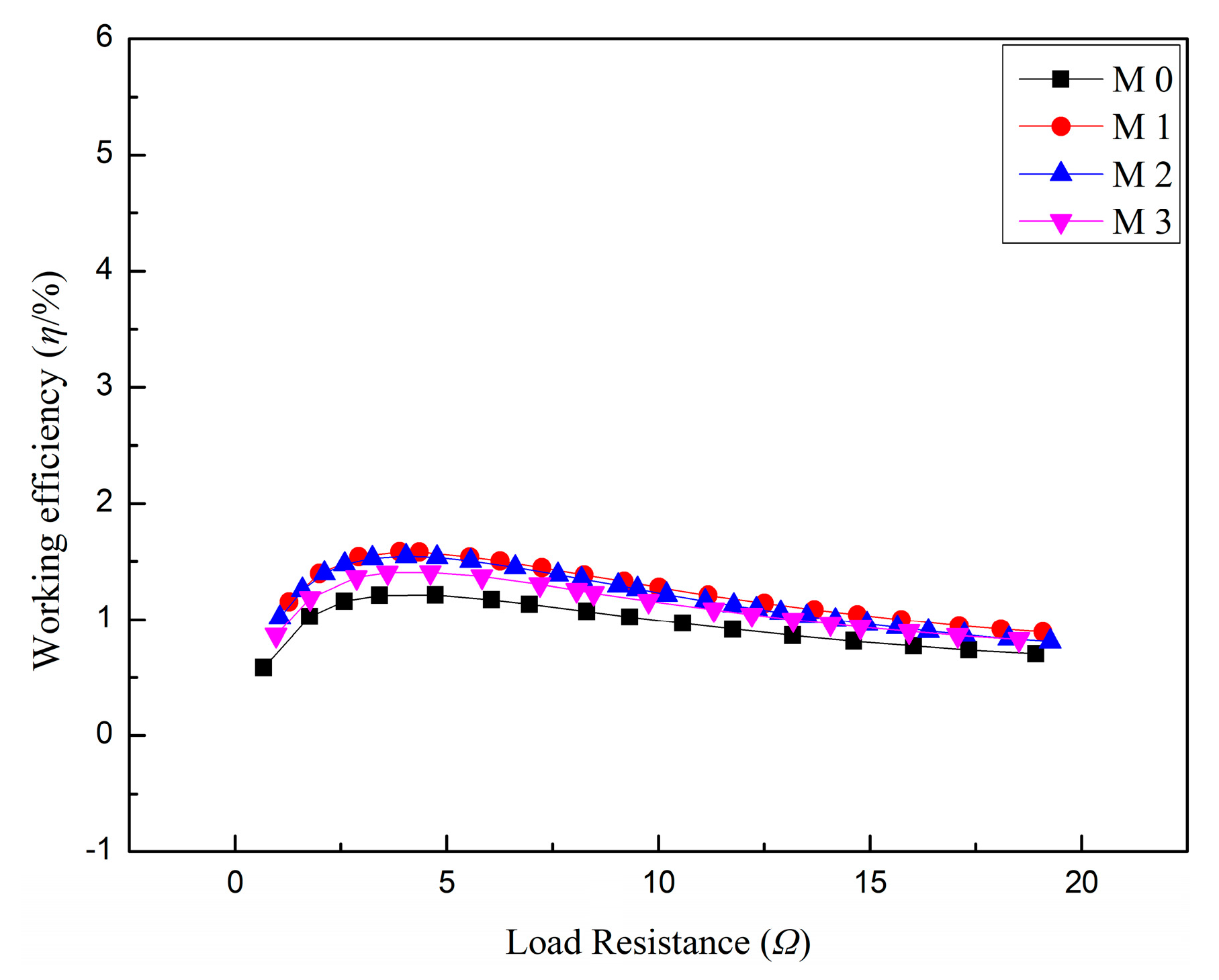
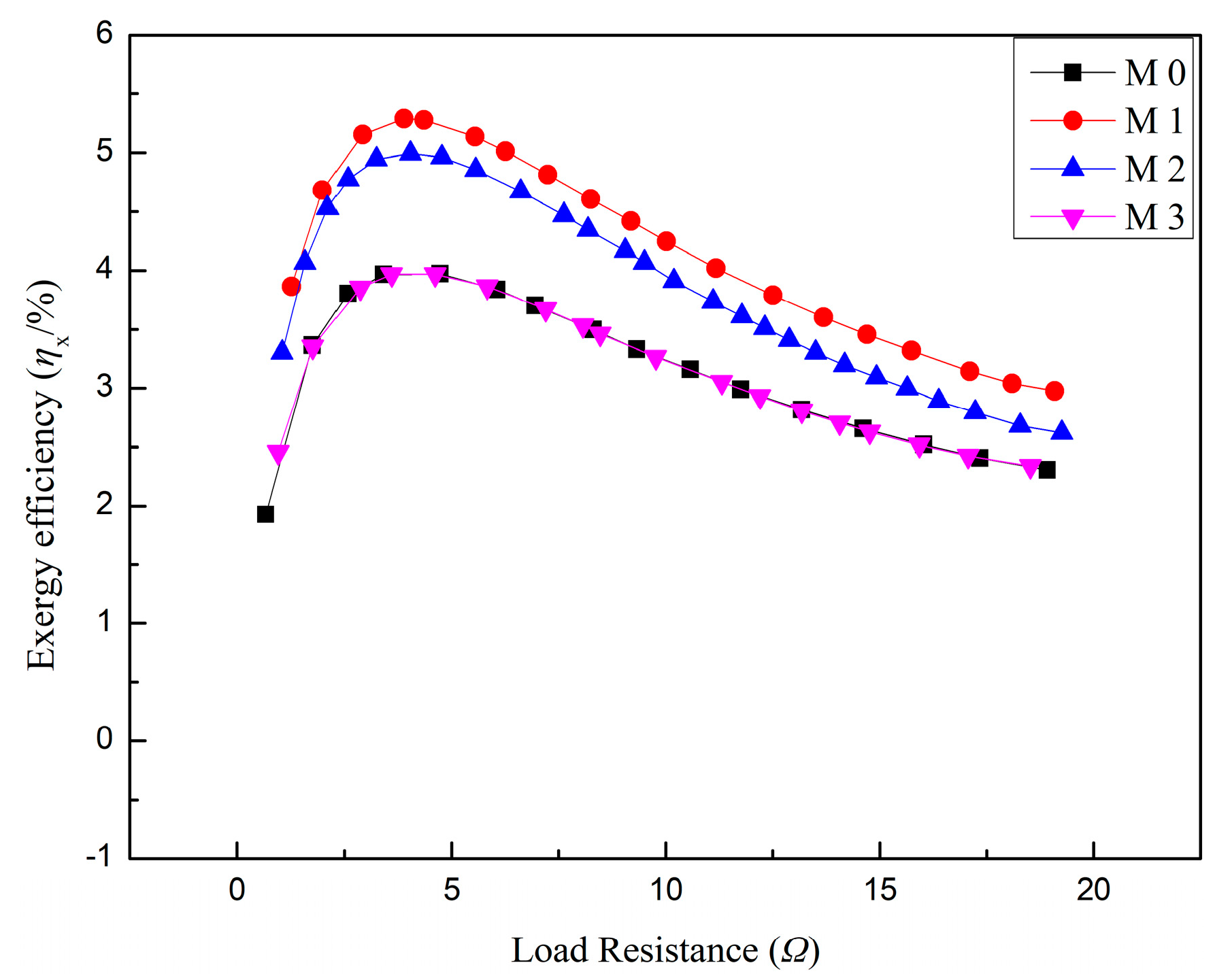
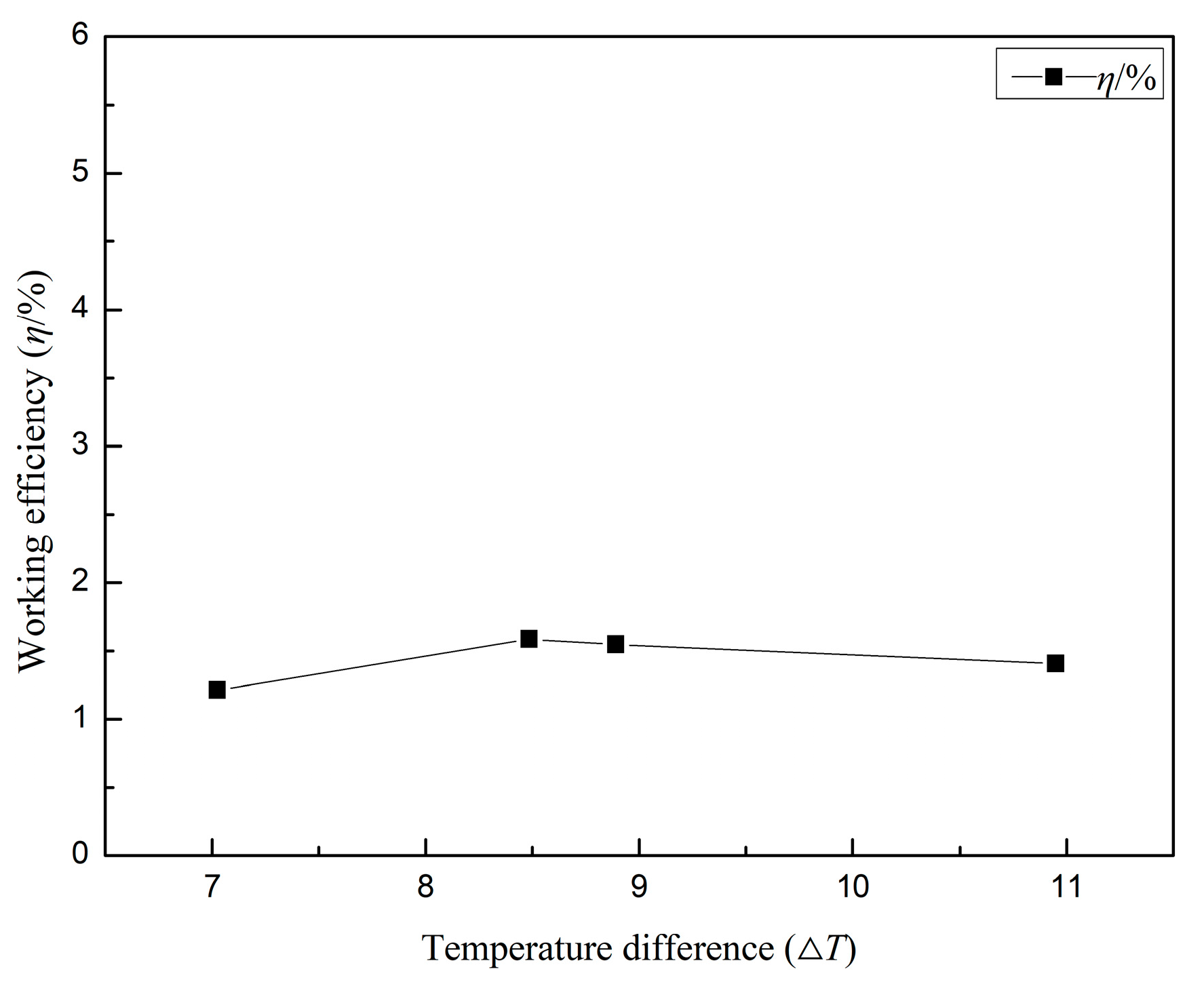
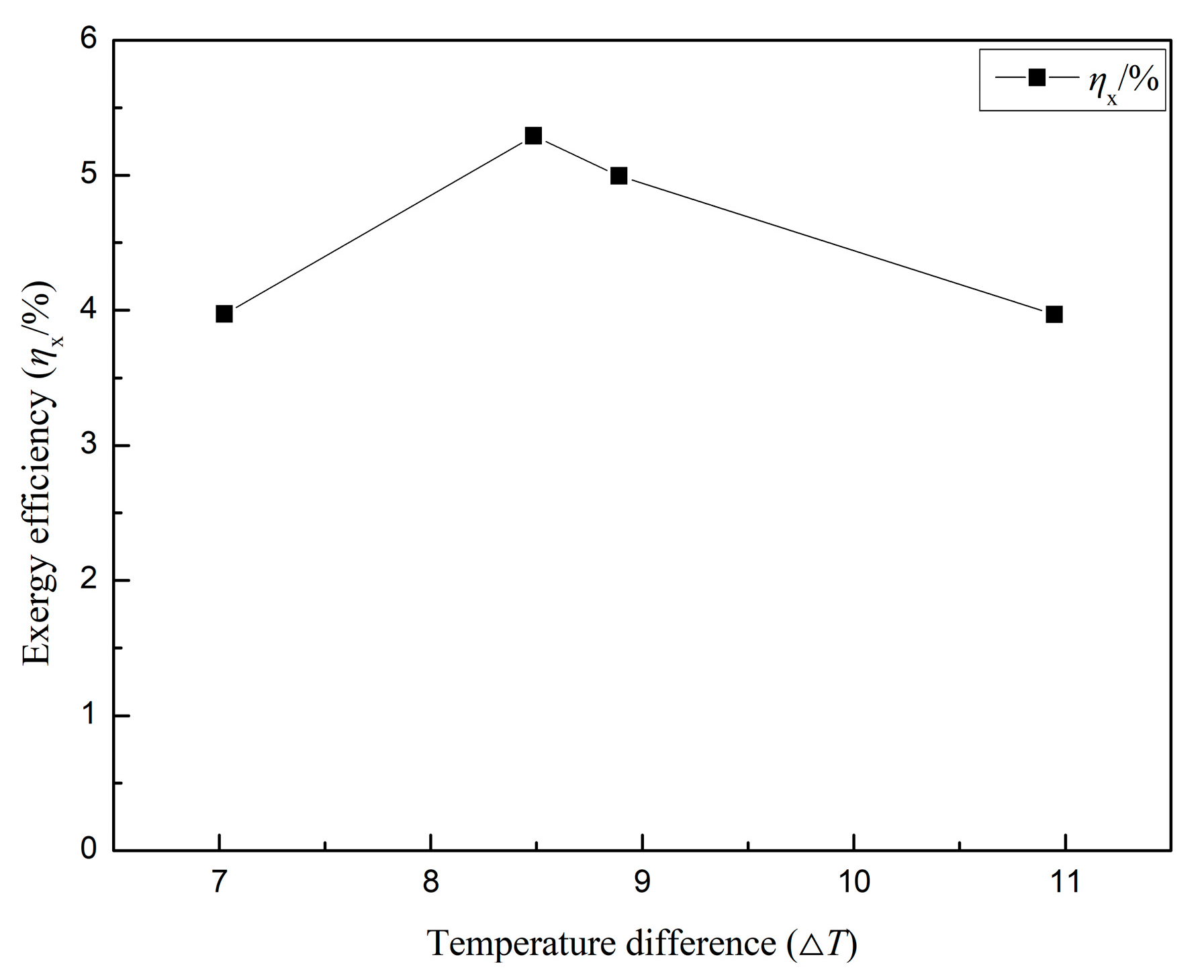
| TEHP1 −12656 −0.3 | Length (mm) | Width (mm) | Height (mm) | Specific Conductance σ (S/m) | Thermal Conductivity κ (W/Mk) | Seebeck Coefficient α (V/K) | Figure of Merit ZT (-) |
|---|---|---|---|---|---|---|---|
| 56 | 56 | 5 | 2.75 | 1.12 | 0.03 | 0.66 |
| Length /mm | Width /mm | Height /mm | Wall Thickness /mm | |
|---|---|---|---|---|
| high-temperature exhaust gas channel | 350 | 70 | 20 | 5 |
| low-temperature cooling water channel | 350 | 70 | 20 | 5 |
| Method | M0 | M1 | M2 | M3 |
|---|---|---|---|---|
| PPI | 0 | 10 | 20 | 40 |
| Porosity | 0 | 98% | 98% | 98% |
| Filling rate | 0 | 50% | 50% | 50% |
Disclaimer/Publisher’s Note: The statements, opinions and data contained in all publications are solely those of the individual author(s) and contributor(s) and not of MDPI and/or the editor(s). MDPI and/or the editor(s) disclaim responsibility for any injury to people or property resulting from any ideas, methods, instructions or products referred to in the content. |
© 2023 by the authors. Licensee MDPI, Basel, Switzerland. This article is an open access article distributed under the terms and conditions of the Creative Commons Attribution (CC BY) license (https://creativecommons.org/licenses/by/4.0/).
Share and Cite
Fu, Y.; Li, Y. Experimental Study on the Working Efficiency and Exergy Efficiency of the Vehicle-Mounted Thermoelectric Generator for Cold Chain Logistics Transportation Vehicle. Processes 2023, 11, 1782. https://doi.org/10.3390/pr11061782
Fu Y, Li Y. Experimental Study on the Working Efficiency and Exergy Efficiency of the Vehicle-Mounted Thermoelectric Generator for Cold Chain Logistics Transportation Vehicle. Processes. 2023; 11(6):1782. https://doi.org/10.3390/pr11061782
Chicago/Turabian StyleFu, Yunchi, and Yanzhe Li. 2023. "Experimental Study on the Working Efficiency and Exergy Efficiency of the Vehicle-Mounted Thermoelectric Generator for Cold Chain Logistics Transportation Vehicle" Processes 11, no. 6: 1782. https://doi.org/10.3390/pr11061782





